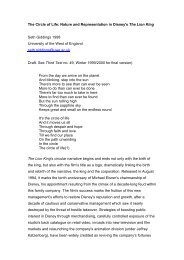“I'm the One Who Makes the Lego Racers Go ... - Seth Giddings
“I'm the One Who Makes the Lego Racers Go ... - Seth Giddings
“I'm the One Who Makes the Lego Racers Go ... - Seth Giddings
Create successful ePaper yourself
Turn your PDF publications into a flip-book with our unique Google optimized e-Paper software.
is to a significant degree defined by this characteristic: <strong>the</strong> first‐person shooter. Car<br />
racing games (and many adventure games such as <strong>the</strong> popular Tomb Raider series)<br />
almost always use <strong>the</strong> third‐person perspective as a default, <strong>the</strong> player’s point‐of‐<br />
view/virtual camera angle always hovers immediately behind <strong>the</strong> avatar as <strong>the</strong> avatar is<br />
directed through <strong>the</strong> three dimensions of <strong>the</strong> gameworld—down paths, through<br />
tunnels, and up hills and structures. However, many do allow <strong>the</strong> option of a first‐<br />
person viewpoint (e.g., <strong>the</strong> player’s point‐of‐view in looking at <strong>the</strong> on‐screen events is<br />
contiguous with <strong>the</strong> view out of a car windscreen from a driver’s point‐of‐view).<br />
This terminology (third‐ and first‐person perspectives) is adapted from film<br />
<strong>the</strong>ory’s notions of subjective camera positioning. As we will see, <strong>the</strong> ways in which a<br />
videogame organizes its interface between player and code (through <strong>the</strong> presentation<br />
of its virtual world and <strong>the</strong> operations of its virtual camera) are often considered key to<br />
<strong>the</strong> player’s subjective engagement or “identification” with <strong>the</strong> gameworld and its<br />
characters.<br />
In “adventure” mode, <strong>the</strong> <strong>Lego</strong> <strong>Racers</strong> 2 player has to first construct <strong>the</strong> driver and car.<br />
Following <strong>the</strong> logic of actual <strong>Lego</strong> construction, <strong>the</strong> driver/avatar is made up from a<br />
selection of bricks “printed” with various faces and indications of clothing. Constructing<br />
<strong>the</strong> car is more complicated. Side‐scrolling menus at <strong>the</strong> top of <strong>the</strong> screen offer a range<br />
of types of bricks, and submenus offer particular bricks within <strong>the</strong>se ranges. When a<br />
specific brick is chosen by <strong>the</strong> player (left and right arrow keys slide <strong>the</strong> menu left and<br />
right and <strong>the</strong> return key is struck once <strong>the</strong> required brick rests in <strong>the</strong> middle of <strong>the</strong><br />
screen) its image hovers over <strong>the</strong> car under construction. The player positions it over




